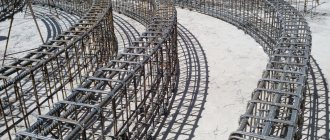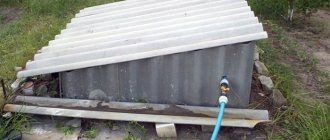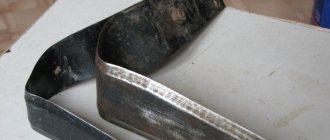Have you ever wondered how a sewer system should be installed in a wooden house, as well as how to make it yourself and install all the elements correctly? Then make yourself comfortable about everything in order.
Not all owners of private houses have the opportunity to connect to main sewer lines. We have to solve the issue in other ways and create an autonomous system. Sewerage in a wooden house can have a completely modern look and meet all sanitary requirements. There are ready-made structures that you just need to purchase and install on the site. You can also make the system yourself, and this option is preferred by most residents of rural or country houses. The main condition will be to study the issue and obtain detailed and high-quality information.
Content:
- Components of the sewer system
- Choosing sewer pipes
- Interior of the sewer
- External sewage system of a wooden house
- cesspool
- Septic tank
- Deep biological treatment stations
- Sewage installation for your country house
- Video on sewerage in a wooden house
Sewage in a wooden house is often autonomous, and you have to arrange it yourself. To do this, you need to know all the intricacies of placing communications both inside and outside the house. You also need to think in advance where the waste collection site will be and how it will be disposed of.
How to arrange a hood
It is worth noting right away: it is needed in buildings with two floors or higher; if the house is one-story, this point can be skipped. As for the sequence of work, it is as follows:
- The outer part should rise above the roof by about 30–40 cm. For this, a ready-made outlet is usually used, which not only ensures normal air exchange, but also protects the inside from precipitation, birds and rodents.
- According to the standards, the fan pipe (as ventilation is called) should be located no closer than 4 meters from the window opening or balcony.
- The closest attention should be paid to the place where the pipe passes through the roof. It must be carefully waterproofed to prevent leaks. For additional protection, a rubber ring or edging is often placed on top to cover the joint.
Components of the sewer system
The sewerage diagram shows the placement of all the constituent elements of the sewerage system. In total, there are three main groups of parts.
Components of the sewer system:
- The internal structure is represented by pipes and plumbing fixtures.
- The external outlet of wastewater is represented by communications that ensure delivery of waste to the processing site.
- Septic tanks and other treatment systems. They can simply accumulate waste or recycle it.
The choice of each element depends on the characteristics of the site itself. Communications must meet certain requirements. Much depends on the volume of operation of the structures.
Design nuances
Before starting work, you will need to draw up an individual pipeline diagram, taking into account the characteristics of the building and the location of the premises. When designing an internal pipeline, an accurate calculation of the location of the drain pipe is required. Only after this can it be established where the remaining sewer elements will be laid.
Stages of drawing up:
- On a piece of paper, preferably in a box, draw a scale plan of the building.
- Select the location where the riser or collector pipe will be located.
- Place marks on all floors of the house where sanitary fixtures will be installed, and route the drain pipes from the riser, taking into account the connecting nodes.
- Measure the length of each part of the drain in the house and add up the resulting dimensions to calculate the exact amount of building materials.
The final stage will be drawing up a diagram of the external system: releasing pipes and laying them before the treatment plant. In this case, it is necessary to take into account all the requirements specified in SanPiN 2.1.4.1110–02 and SNiP 2.04.03–85.
Choosing sewer pipes
It is important to understand how to make a sewer system in a wooden house yourself, even if the work is performed by professionals. You can choose the material yourself. And orientation in all processes will help control the installation of wastewater disposal systems.
It is best to use plastic pipes for sewerage. The optimal diameter for risers is 110 mm, and for bends - 50 mm. External sewerage can be made of eurocast iron. Popular use of products made from domestic materials.
Plastic pipes for external sewerage are also popular, but their characteristics have distinctive features from those for internal drainage.
Features of different materials:
- Cast iron. Able to withstand significant loads and last a long time. But the material is heavy and fragile. During operation, corrosion and roughness are formed, which negatively affects the permeability of the pipes.
- Polypropylene. Has no disadvantages. Among the advantages are flexibility, lightness and stability.
- Polyvinyl chloride. The material will last a long time. It is quite durable, lightweight and affordable. But there is no resistance to high temperatures.
Eurocast iron has undeniable advantages. This is a sustainable, durable and environmentally friendly material. Pipes are installed using clamps. Be sure to use rubber gaskets, and the joints are tightened together with bolts.
Domestic cast iron is not inferior in quality to European analogues. But there are slight differences in the assembly. To connect them, the socket method is used. The communications are inserted into each other and then sealed with a bundle.
Plastic pipes for external and internal sewerage differ in color. For the street, bright shades are used for communications so that they can be noticed during excavation. The pipes are also more durable so that they can withstand internal and external pressure.
Well
The most accessible and simple method of meeting water needs is digging a well. Its advantages are low cost and simplicity of the device, but this method of water supply has much more disadvantages. First of all, this is its performance, that is, the volume of water that you can get in an hour. The maximum productivity of the well is 200 liters per hour. This volume is usually enough to water the plantings, cook dinner and wash the dishes. And not simultaneously, but one by one, however, if the well is deep and several rings are filled with water, then more water can be pumped out at a time. On average, one ring is 600 liters of water. The second significant disadvantage is the large variability of water quality, and the need for its bacteriological examination and chemical analysis.
The quality and quantity of water in a well are influenced by aquifer inflows and soil composition. In sandy soils and clays, the water inflow will differ by 2-3 times. In clay soils, there can be an influx of from half a ring to one ring or more overnight. The first is considered a weak influx, the latter is considered good. In sandy soils, the inflow is greater and its permeability is better, so in sandy soils the water in the well costs one and a half rings or less, despite the good inflow, and in clay and loamy soils, water is retained in the soil layers and accumulates in wells up to 10 or more rings, due to stagnation. It is recommended to pump such wells every year, pumping out all the water, allowing it to be completely renewed.
Well pumps for home water supply
Surface well pumps are installed on the surface, and a suction tube with a valve is immersed in the water. Typically, the productivity of such pumps is 4-8 m3 of water per hour, and the pressure does not exceed 55 meters. Well surface pumps are divided into centrifugal and self-priming.
Centrifugal surface pumps are single-stage and multi-stage, do not have an ejector and can lift water to a height of 7-8 meters. Single-stage centrifugal pumps are simple in design, quite reliable and inexpensive, but they are noisy. Multistage ones have lower noise levels and energy consumption. The pressure and flow parameters of these two types of pumps are the same.
Self-priming surface pumps are equipped with a built-in or remote ejector, which allows you to lift water from a depth of more than 8 meters. Models with a built-in ejector are more expensive and noisier than centrifugal pumps, and it is better to install them in a separate room outside the house. Models with a remote ejector are practically silent; the ejector is located in a well or borehole, and are capable of lifting water from a depth of up to 45 meters. At the same time, such pumps are more difficult to install and operate, and are also quite sensitive to the presence of silt and sand in the water.
Well submersible pumps, unlike well pumps, have a shorter and wider body; they are suitable for shallow immersion depths.
If the water in the well is at a depth of more than 8 meters from the surface, then you should use a submersible pump that is completely immersed in water. When the water level in the well fluctuates, it is necessary to control the position of the pump, preventing it from being above the surface. This can lead to overheating and breakdown, which means you will need to replace the pump with a new one. This control is definitely a disadvantage of using a submersible pump. However, if the submersible pump has a float switch, then failure can be avoided, since the float will turn off the pump in time when the water level changes.
Submersible well pumps are divided into centrifugal and vibration. Centrifugal ones provide a larger water supply, are more expensive than vibrating ones, usually have a lower water intake and are more preferable for wells, since they are almost devoid of vibration, and thus do not have a destructive effect on the walls of the well.
Vibrating ones have a lower cost, but also lower power, and are also not recommended for wells, due to the presence of strong vibration, which contributes to sanding of the well and a decrease in water inflow. Such pumps come with upper and lower water intake. Models with an upper intake are less susceptible to sucking silt from the bottom of the well, but at the same time more sensitive to a decrease in water level.
Interior of the sewer
The main thing is to take care of the close location of all communications horizontally and vertically. This reduces the length of the pipes, which will allow wastewater to be discharged faster. You also need to take care of your convenience.
Internal sewerage communications:
- Bathroom, sink, toilet and other plumbing fixtures;
- Communication outlets;
- Risers;
- Ventilation tube.
The diameter of pipes for internal sewerage is usually 40-50 mm. Only the toilet requires a size of 110 mm. All pipes are connected to a common riser. You can use tees for connections. It is recommended to install inspections at each bend of communications. This will allow you to quickly deal with any blockage.
Pipes indoors can be hidden in walls, niches or special boxes.
It is imperative to provide for the installation of water seals. The installation of the ventilation pipe is also important. It not only removes unpleasant odors, but also increases the service life of the entire system. Combining fan communication with other house hoods is prohibited.
External sewage system of a wooden house
When considering how to install a sewer system in a wooden house, many questions relate to the external arrangement. The main requirement for external sewerage pipes is compliance with the slope. The indicator depends on the diameter of communications. Usually it fluctuates around 2-3 degrees. The effluent will eventually end up in a filtration or storage facility. This can be a septic tank, a cesspool and a biological treatment station.
cesspool
The simplest storage tank is a cesspool. It's just a well with walls but no bottom. Concrete rings or bricks are used to construct the walls. This is a simple design and does not require cash injections. But there are many more disadvantages of capacity.
Disadvantages of a cesspool:
- It is impossible to properly clean the drains. The waste can end up in the ground and contaminate drinking water sources.
- It will be necessary to make a large hole, since a large amount of waste is discharged.
- The container must be pumped out periodically.
A cesspool is considered an outdated option for collecting wastewater. She doesn't perform her functions well. It can be installed in a summer cottage where people come only on weekends.
Septic tank
A modern method of wastewater treatment is a septic tank. The design of the device includes several compartments. The first chamber performs filtration. The solid parts settle to the bottom, and the liquid passes into the next compartment, where anaerobic bacteria work. Cleaning is completed in filtration wells or fields.
You can find storage septic tanks. This is an improved version of cesspools.
Concrete and plastic are used for the septic tank. The volume is calculated individually, depending on the needs of the family. The amount of plumbing in the house is also important.
Septic tanks also have negative aspects. This is how the distance of the structures from the house and sources of drinking water is determined. Cleaning is not always high quality. Septic tanks need to be pumped out periodically.
Deep biological treatment stations
A biological treatment station will allow you to clean wastewater efficiently. At the output, you can get a liquid that will be 98-99% purified. Such water is often reused for household needs.
The stations operate using aerobic bacteria. Thanks to their active work, purified liquid and sludge are obtained. It is often used for garden fertilizer.
Even the deep cleaning design has disadvantages. This is an expensive device. The cost is several times higher than the price for a septic tank. In addition, the stations require a connection to the electrical network to operate. Bacteria work using oxygen, which is supplied to the containers using fans.
The biological treatment station is quite convenient to use. This is a compact device that does not require pumping. You will be pleased with its attractive appearance and the absence of an unpleasant aroma. In addition, electrical costs are insignificant. And the costs of purchasing the structure pay off over time.
Installation of the riser
This is the core part to which all elements of the internal system are connected, so special attention must be paid to it. Instructions for carrying out work:
- You need to assemble the system from the point of connection to the output. Pipes must be installed with their sockets facing up, so the resistance to the movement of liquid inside will be much less.
- It is imperative to install an inspection on each floor, so that in case of clogging you do not have to disassemble the system and quickly get to the problem area. Holes of a slightly larger diameter are made in the interfloor ceilings, which, after installing the riser, are sealed with cement mortar.
- Plan the locations of the clamps in advance in order to drill holes there and insert dowels. After assembly, this can no longer be done. The fastenings can be adjusted using stud screws.
- Bends with a suitable diameter and location are installed in the right places.
By the way!
After assembling the riser, it is most often hidden behind a door, plasterboard structure or any other element. To increase comfort, it is recommended to additionally soundproof the pipe with mineral wool.
Sewage installation for your country house
The quality of work is guaranteed if you turn to professionals. You can try the installation yourself. Then you will need to study the technology in more detail and follow all the rules.
Basic rules for sewer installation:
- It is necessary to immediately determine the groundwater level. Otherwise, you can spoil the drinking source both on your site and in neighboring ones.
- It is necessary to maintain a certain distance from utility and residential buildings and sources of drinking water.
- When purchasing cleaning structures, you need to carefully evaluate the device data sheet. The degree of filtration must comply with sanitary standards.
- You need to carefully study the instructions. Incorrect installation and operation negatively affect the operation of the device.
If all requirements are met, the drainage system will work properly. Sewerage in a wooden house with your own hands can function perfectly if you follow the installation rules and regulations. The main thing is to study the installation technology in detail.
The sewage system of a private house consists of elements of internal and external outlets, as well as a treatment facility. Much attention is paid to the selection of materials for communications. It is better to entrust sewerage installation to professionals. When choosing a filtration installation, consider a cesspool, a septic tank and a biological treatment station.
Equipment selection
One of the most critical operations in the process of performing preparatory work is the choice of material and technical characteristics of the pipeline. If previously the undisputed leadership in the market belonged to cast iron pipes, in recent years they have partially lost their position to plastic (PVC) products. Debates about the best material continue to rage, as each provides specific benefits to the user. The advantages of cast iron pipes include:
- high mechanical strength;
- durability and reliability, especially when applying protective coatings;
- good sound insulation and thermal insulation;
- ease of creating high-throughput systems.
Here are the main advantages of plastic pipes compared to cast iron:
- lower price (in most cases);
- resistance to corrosion and chemicals;
- low weight, which facilitates transportation and installation;
- no need for complex plumbing and welding work.
Therefore, when choosing a material for each specific pipeline, it is necessary to take into account such operational characteristics as permanent and temporary loads on the pipeline from the external environment and flow intensity. In addition to choosing pipes, you need to decide on the configuration and type of additional elements. In any case, you will need adapters, turns, and fastening mechanisms.
Particular attention will have to be paid to the choice of equipment for an autonomous external sewerage system. You will have to select reliable filtering and drainage mechanisms (for example, a special well) that eliminate the possibility of groundwater clogging
The installation location of the septic tank must not only correspond to the route of the main line, but also ensure the convenience of connecting the sewage system, since the contents of the septic tank should be pumped out at least once every two years. In this case, the permissible distance from the external walls of the house is at least 9 meters, and the minimum depth is 1.5 meters. In areas where deep soil freezing is possible, the depth indicator is further adjusted.










